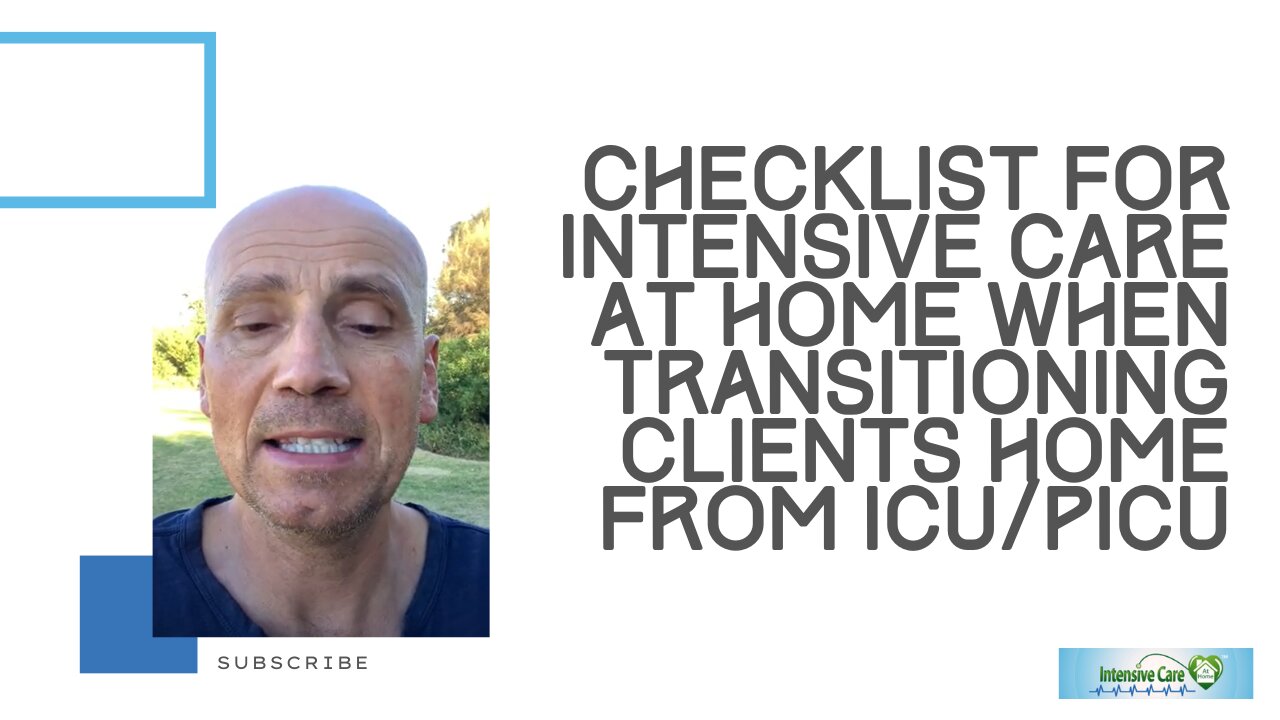Premium Only Content

Checklist for Intensive Care at Home When Transitioning Clients Home from ICU/PICU
Checklist for Intensive Care at Home When Transitioning Clients Home from ICU/PICU
Book your free 15-minute phone consultation here
http://intensivecarehotline.com/scheduling-appointment/
Call directly 24/7
+1 415-915-0090 USA/Canada
+44 118 324 3018 UK
+6141 094 2230 Australia
Email [email protected]
Get 1:1 consulting and advocacy
1:1 phone counselling
http://intensivecarehotline.com/one-on-one-counselling/
Become a member for families of critically ill Patients in Intensive Care
https://intensivecarehotline.com/intensivecaresupport-org-membership/
Immediate action steps http://intensivecarehotline.com/take-control-take-charge/immediate-action-steps/
https://intensivecareathome.com
And if you need a medical record review, click on the link and we can help you with reviewing your loved one’s medical records while they’re in ICU.
https://intensivecarehotline.thrivecart.com/review-of-medical-records/
Facebook Page: https://www.facebook.com/IntensiveCareHotline
Twitter: https://twitter.com/icuhotline
Hi, it’s Patrik Hutzel from Intensive Care at Home, where we provide tailor-made solutions for long-term ventilated adults and children with tracheostomies and where we also provide tailor-made solutions for BIPAP and CPAP dependent adults and children on non-invasive ventilation, as well as home TPN and otherwise medically complex patients, and we provide a genuine alternative to a long-term stay in intensive care.
So today, I want to talk about a client that is inquiring about our service and asking, “What’s our checklist when we onboard clients to go home from intensive care?” And of course, we have a checklist when we onboard clients so they can go home from intensive care. And I’ll quickly go through the checklist so that you have an idea how we approach it.
Obviously, there’s a list of equipment that we need to go through, especially when it comes to mechanical ventilation. There are usually two ventilators needed. There are two suction units needed. There are spare tracheostomies needed, assuming a client of ours is ventilated with a tracheostomy. If they are non-invasively ventilated like BIPAP or CPAP, they don’t need spare tracheostomy equipment, but they still need two ventilators. They also often need the suction machine. Definitely, clients with tracheostomy and ventilation need a suction machine. Most clients with BIPAP and CPAP that are under our care need suction machines as well.
Obviously, they need resuscitation bags. If they’re having a tracheostomy, they need two different sizes. If they’re, for example, having a size 8 tracheostomy, they need also a size 7 tracheostomy as backup. They need a resuscitation bag with a PEEP valve and a resuscitation mask. They need oxygen cylinders or an oxygen concentrator, oxygen tubing, nebulizer set humidifiers.
If they’re having a PEG (percutaneous endoscopic gastrostomy) tube or a nasogastric tube, they need a feeding pump, enteral feeding giving sets. They need dressings for the tracheostomy. They need dressings for the PEG tube. Gloves, of course. Sometimes sterile gloves, especially when it comes to tracheostomy dressing changes. Goggles for the staff. Normal saline ampoules, chlorhexidine, as well as a tablet crusher most of the time with a bladder syringe as well.
A urine bag if clients have a suprapubic catheter or sometimes even an indwelling catheter. And the list goes on such as stethoscope, blood pressure cuff, monitor, of course, to monitor heart rate and oxygen saturation. Often a special care bed, a hoist lifting machine is needed. Ideally a ceiling hoist, especially when it comes to long-term patients. Tracheal dilator and so forth.
Now, also comes down to that a 24-hour nursing roster with intensive care nurses is in place. A care and activity plan, clinical observation charts, ventilation charts, standard shift check charts, and all of our clinical documentation needs to be in place as well before we can safely take a patient home from intensive care. But it’s absolutely doable. We have done it many times.
And if you are in a situation where your loved one is stuck in an intensive care bed, long term with ventilation or tracheostomy or any of the other situations that I’ve just mentioned, if they’re on BIPAP or CPAP and they can’t leave intensive care, or sometimes patients are stuck on a respiratory ward or floor as well and they can’t live there. Or sometimes patients are stuck on a hospital floor with a tracheostomy, and they can’t go home because no one in the community can look after them. Then, you should contact us as well.
Continuation...
https://intensivecareathome.com/checklist-for-intensive-care-at-home-when-transitioning-clients-home-from-icu-picu/
-
 49:41
49:41
Intensive Care at Home
23 hours agoMND in ICU: BIPAP, Tracheostomy & Evidence-Based Home Care with 24/7 ICU Nurses
51 -
 1:31:56
1:31:56
Michael Franzese
17 hours agoWill NBA do anything about their Gambling Problems?
105K22 -
 57:26
57:26
X22 Report
7 hours agoMr & Mrs X - The Food Industry Is Trying To Pull A Fast One On RFK Jr (MAHA), This Will Fail - EP 14
78K48 -
 2:01:08
2:01:08
LFA TV
1 day agoTHE RUMBLE RUNDOWN LIVE @9AM EST
136K11 -
 1:28:14
1:28:14
On Call with Dr. Mary Talley Bowden
5 hours agoI came for my wife.
15.3K20 -
 1:06:36
1:06:36
Wendy Bell Radio
10 hours agoPet Talk With The Pet Doc
51.9K28 -
 30:58
30:58
SouthernbelleReacts
2 days ago $7.50 earnedWe Didn’t Expect That Ending… ‘Welcome to Derry’ S1 E1 Reaction
31.8K9 -
 13:51
13:51
True Crime | Unsolved Cases | Mysterious Stories
5 days ago $17.84 earned7 Real Life Heroes Caught on Camera (Remastered Audio)
48.9K11 -
 LIVE
LIVE
Total Horse Channel
16 hours ago2025 IRCHA Derby & Horse Show - November 1st
120 watching -
 4:19
4:19
PistonPop-TV
6 days ago $7.81 earnedThe 4E-FTE: Toyota’s Smallest Turbo Monster
41.5K